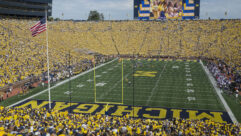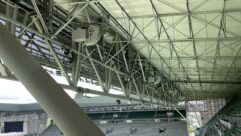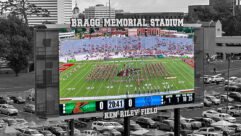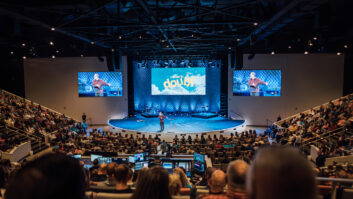
The Buzz: Installation Spotlight:
Aloha Stadium, Honolulu
Feb 1, 2007 12:00 PM,
By Trevor Boyer
Aloha Stadium’s Audio Upgrade

To ensure high-quality audio with minimal interference, the crew at Aloha Stadium uses a Soundcraft mixer, a Lectrosonics VRM (receiver master) running LecNet software, six VRS receiver modules, three Lectrosonics UM-400 100MW digital hybrid wireless transmitter packs modified to use with three referee switches, and four Countryman EMW microphones for referee use.
Hawaii does not have a professional football team, but every year in January, the NFL brings its annual Pro Bowl game to Aloha Stadium in Honolulu. For decades, however, certain aspects of Aloha Stadium’s audio system were not quite up to NFL standards, including the feed from the referee’s wireless microphone to broadcasters and to the public address system. Considering the amount of radio interference in the area — the Army’s Camp Smith, Honolulu Airport, and Pearl Harbor are all within a few miles — the need for a powerful, frequency-agile RF microphone system was clear.
Another nagging problem for the stadium, which the University of Hawaii’s football team also calls home, was that its IQ system was collecting dust. IQ is Crown’s network control software that allows operators to adjust volume, delay, and other amplifier parameters via PIP hardware processor cards that are installed in each amp. The operators at the stadium — part-time employees, rather than audio engineers — couldn’t control the amplifiers over the network because the IQ software was running on an old DOS-based PC that required mastery of C: prompts. More than a decade ago, Aloha Stadium initiated a wide-reaching, multimillion-dollar overhaul of its audio system that included Atlas, Apogee, and EV speakers, new wiring, and the Crown amps that system operators could — at least theoretically — control via computer. But the Stadium Authority at the time never retained any firm for ongoing maintenance of the audio system.
A couple of years ago, however, that job went to Senator Mike Michaels, through his company, Studio M Productions. Michaels has been involved with the stadium’s audio system for decades — for the most part as a radio engineer involved in doing remote broadcasts of football games for AM stations. In that position, he learned the strengths and shortcomings of the stadium’s audio system.
Now, Michaels and Studio M have a contract for annual maintenance and development of the Aloha Stadium system. The contract involves two annual walkthroughs, one before the beginning of the college football season and the other prior to the Pro Bowl. Michaels and his employees use handheld TerraSonde Audio Toolbox units for acoustic analysis. The contract also requires that Michaels’ team coordinate with broadcasters — the TV trucks — to make sure there are no conflicts among the various radio frequencies used throughout the stadium. This had been a problem throughout the 1990s, when the stadium used an RF microphone system that was not frequency-agile, and also underpowered.
Early on, Studio M decided to upgrade the stadium’s radio mic technology to a Lectrosonics Venue system. Last football season, 2005-2006, local dealer Jim Walters Company brought in a test system that survived the whole season and eventually became the permanent system. This setup includes a Lectrosonics VRM (receiver master), six VRS receiver modules, three Lectrosonics UM-400 100MW digital hybrid wireless transmitter packs modified to use with three referee switches, and four Countryman EMW microphones for referee use. LecNet software runs the VR receiver. It allows the stadium crew to spot and avoid radio frequency interference before it becomes a problem.
“With the NFL, but even with the colleges that come in, [the PA system operators] can spot interference using the LecNet software on the computer and do the frequency scan and say, ‘Oops, we’re seeing some interference there,’ ” Michaels says. “We’ll say, ‘OK, let’s just go to a clear frequency.’ Being in an RF hotbed is no longer an issue.”
The LecNet software was installed on a Windows 2000-based Dell Axium computer, and Crown’s IQ software was soon loaded onto the same system. Concurrent with the computer upgrade, Crown also installed new PIP processors in the amps because Aloha Stadium had been an early adopter of the technology and there had were some noise issues.

Now that the IQ system is finally accessible outside of the archaic DOS environment, audio system operators have a much easier time tweaking the volume and other amp parameters via the PIP processors, such as equalization, delay, limiting, thermal protection, and reporting. The IQ software makes it easy for the stadium crew to toggle among presets for the PA system.
“For example, when the NFL comes in for the Pro Bowl, we have stored in the IQ system settings that we use for the NFL function,” Michaels says. “They come in and they say, ‘Well, we want to put some speakers on the field in additions to your sound system [for the halftime show].’ So we go in and we retime the system and reset all the PIPs. We hit a button and it’s ‘NFL Game.’ We hit another button and it’s ‘NFL Halftime Show.’ ”The audio system operators now get graphical and audio feedback of their changes via the IQ software.
“If we get complaints that the sound is too loud in a particular section of the stadium, we can go right to the amplifier that controls those speakers in that section of the stadium, on that level of the stadium, and turn it down,” Michaels says.
For the NFL and its high-profile Pro Bowl, however, the primary concern about the Aloha Stadium PA system is the output of the referee’s microphone, which is broadcast more or less directly to television. With the new Lectrosonics transmitters, receivers, and software, Michaels says he can finally feel confident in the PA system’s performance on game day. Sound mixers in the broadcast trucks tested the system four days before the Pro Bowl and heard the demo message from the referee microphone, a line-level feed from a DA.
Michaels reports that the broadcast sound mixers who worked on the 2006 Pro Bowl game called it the best referee mic feed that they’d heard in any stadium they visit. The team used the same system for the 2007 game, which took place shortly after press time.
SUBSCRIBE TO SOUND & VIDEO CONTRACTOR E-NEWSLETTERS!
Sound & Video Contractor EXTRA
Systems Integration Special Focus series:
- Houses of Worship
- Corporate AV
- Residential AV
- AV Over Fiber
- AV in Education
Breaking industry news in your email inbox every other week!
Subscribe atwww.svconline.com










